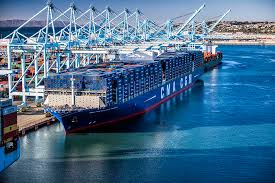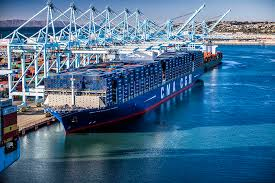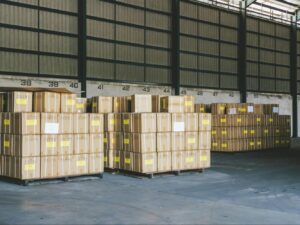Did you know, AMS’ Witherspoon facility in Valencia could hold nearly 3 ½ Mega Ships the size of the Benjamin Franklin?

Mega Ships, Ports, and the Flow of Goods
AMS likes to be up to date with what’s going on in the ports around the world, and of course there’s a reason. If there is a work-stoppage, backlog or congestion, or construction at a major port, it affects everyone who ships products. We are a large international fulfillment company located near the ports of Los Angeles and Long Beach, we do a lot of shipping for our clients, and we also are a Foreign Trade Zone. This gives us the ability to act as a port, admitting merchandise into the Zone for clients that import merchandise through U.S. Customs.
Recently conversation has turned toward Mega Ships, and the arrival in December of the largest container ship ever at a North American port. The ship, named the Benjamin Franklin, was 80% full, with a capacity of 18,000 20-foot containers. And still, as huge as this ship is, it is not the largest container ship in the world. The largest ship, which is too large for a U.S. port, travels the Asia-Europe route, holding 20,000 20-foot containers.
Compare this to ten years ago when the average container ship was 1/3 the size of the average ship today. Ports have had to keep up, and over the years we’ve seen the Los Angeles and Long Beach ports undergo projects costing millions of dollars, deepening channels, investing in cranes and equipment, and expanding terminals in order to handle the arrival of the larger ships. These hugs ships, bringing in such high volumes, put pressure on the entire supply chain, including dockworkers, truck drivers and rail carriers.
We might ask why the mega ships are being built, and are they a benefit or detriment to the ports, to the flow of goods, and to international fulfillment companies. Apparently, with borrowing costs so low, the investment in building such a large ship was considered good business; a way of cost-cutting through consolidation. Looking forward to moving more goods, and using less fuel, a number of these ships were built. But apparently too many of these ships were built, so now the ships have greater capacity than there is demand. This leads to falling cargo rates and shipping companies engaging in vessel-sharing in order to make sure the larger ships are full.
The ports of Los Angeles and Long Beach are large enough to handle a vessel this size, and for the arrival of the Benjamin Franklin they had advance notice of nearly two weeks, as well as a great deal of information on the cargo. This information helped Port officials and the dockworkers, truck drivers and rail in coordinating their efforts in order to handle the challenge and the work flow. Vessel-sharing also complicates matters for the Port, so all of the information shared by the Benjamin Franklin was vital to the success of that visit.
The Benjamin Franklin is expected back again in February, with the Ports once again required to go above and beyond with regard to planning and coordination. There are questions as to how the Ports can sustain this level of planning routinely. So, while the mega ships may be cost-cutting for shipping, and while there is no measurable impact on international fulfillment, the ships are presenting a challenge to ports, dockworkers and transportation.
Just to give an impression of how much cargo comes in on one of these ships, imagine this: If the ship is full, and the containers are unloaded and lined up end-to-end, what distance do you imagine they would go? The answer: From Santa Monica to Santa Barbara!




